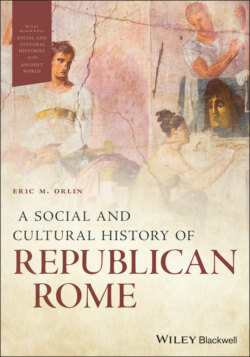Читать книгу A Social and Cultural History of Republican Rome - Группа авторов - Страница 21
Conclusion
ОглавлениеThe sources for Roman social and cultural history are thus numerous and impressively varied, but not without challenges. One issue that will crop up repeatedly throughout this book is the balance between synchronic history and diachronic history.
Synchronic history means taking pieces from different times (chronos) and putting them together (syn) to form a single picture. Roman historians are often to forced to write synchronic accounts because of the nature of our evidence. For example, we may learn about Roman fathers from a document in one period and about Roman mothers from a slightly different period, and historians combine the two to provide a picture of “the Roman family.” The problem, which sharp-eyed readers might have noticed, is that there may never have been a single time when the Roman family looked exactly like our picture. Synchronic history offers a composite image that can help us understand a subject broadly but sometimes the image remains fuzzy as the details do not match up fully.
Diachronic history goes through (dia) time (chronos) and so focuses more attention on documenting change. Tracing the rise and fall of an empire is a good example of diachronic history. Our evidence for military affairs often allows us to know the specific battles and the dates that allowed an empire such as Rome to grow, and so we can describe the steps by which Rome grew into an imperial power.
As we embark on our exploration of Roman social and cultural history, we thus face two challenges. One is to combine the literary and material culture sources into a single picture, and the second is to employ both synchronic and diachronic history to understand Roman society. Each historian will find a different balance for these two challenges, which explains why each historian’s picture of Roman society looks slightly different.
Let us close this chapter by taking the Roman family as an example of how we might proceed. We could start with the stories about Romulus and note that some literary sources suggest that the Roman family may have been dysfunctional by our standards. At the same time, we have to note that this story concerns the elite – the founder of Rome! – and we might wonder whether all families felt this way. Plautus and Terence left us comedies from the second century that feature fictional families with stereotyped relationships: a doddering father, a shrewish wife, and a young man mooning over the girl next door, and we might wonder how much truth lies in these stereotypes. Funerary inscriptions written by a husband for his wife or vice versa offer a different kind of evidence and suggest a type of devotion that looks different from the comedic picture. Cicero’s letters offer another type of evidence from the first century BCE and show us his personal devastation when his daughter died as a result of childbirth. The houses from Pompeii and elsewhere show that Roman houses, both rich and poor, had few spaces that family members might consider their own private space, and so raise questions about what family life looked like on a day-to-day basis. Each isolated piece of evidence by itself can give us only a partial or even misleading picture. Taken together, however, as we will do in the pages that follow, these sources will allow us to develop a rich picture of Roman life, a life that was both like and quite unlike modern Western experiences.
